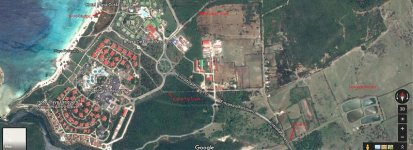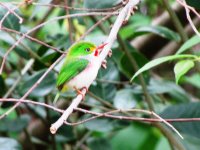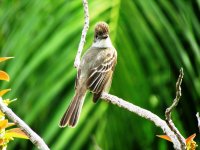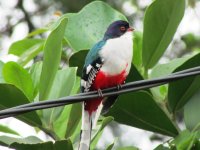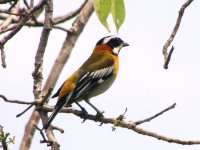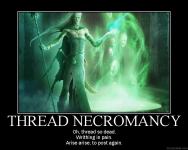shymollymawk
Well-known member
Introduction
Cuban bird reports are like buses. You wait ages, and then two come along (see Adare’s “Cuba with a few birds” posted 5th May 2017). This gives a useful insight into birds likely to be found at the western end of Cuba, and can be compared with this report from the eastern end. His is also like mine a “non-birding” holiday (that’s what I tell my family too).
This is a report on an all-inclusive holiday at Playa Pesquero Hotel, organized by Thomas Cook. We flew from Manchester to Holguin airport, and then an hour by bus to the resort. After booking the holiday I came across a trip report by John Yates (JY), who stayed here in August 2006 (http://www.birdtours.co.uk/tripreports/cuba/cuba-7/cuba-august-06.htm). This was very helpful in finding our way around. Blake Maybank’s trip reports also had a lot of information. We also went on two sight-seeing day trips and had a morning’s birding with Carlos, a local bird guide ([email protected]). We were there in the last two weeks of April.
Basics
Cubans are poor. So some tipping is to be expected when receiving a service. The 50c coin is very useful, rather than a peso (which is still only 78p or so), and both parties will be happy. Tipping appropriately is a bit of an art – the Canadians tip lavishly, but everyone makes their own choices. There is not a lot to buy in Cuba either. The people are very friendly and it seems very safe. The weather while we were there was cloudy and slightly windy, but still warm, for the first week, and then sunny for the rest. We had occasional tropical downpours, which dropped migrants in. Our hotel was very good value; we could choose several restaurants to eat at instead of the buffet (which still had a good choice) on half the nights we were there. The Seafood, Caribbean and Romantica Restaurants were great (lobster – yum), but sadly the Cuban Restaurant on our night was terrible.
Localities
The thumbnail shows some of the localities mentioned around PP
Hotel Playa Pesquero
Lots of birds to be seen, and the occasional surprise like a West Indian Whistling Duck flying past our porch after a tropical downpour. Red-legged Thrush, Northern Mockingbird, Cuban and Tawny-shouldered Blackbirds, Kingbirds, common doves, Western Spindalis, Greater Antillean Grackles and Cuban Oriole were easily seen. Cuban Emerald wasn’t, possibly because it had moved to its breeding sites. Antillean Nighthawks turned up in numbers on the 22nd, and were then easily seen in the early morning and late afternoon hawking overhead. One even swooped in one afternoon to perch in a small tree near our room. Sitting in the porch chairs birding was always interesting.
Blue Bridge Mangroves (Ecological Preserve)
This is JYs “Ecological Preserve”, which is between the beach and the Hotel Blau Costa Verde next door to the east. It is a largish area of mangroves with a large brackish smelly lagoon in the middle, crossed by the Blue Bridge. This was a nice circular walk in the early morning or evening, with always something to be seen or dropping in. Birds usually present included Yellow-crowned Night Heron, Snowy, Cattle and Great Egrets, Little Blue Heron, Green Heron, Clapper Rail, Black -necked Stilt, Spotted Sandpiper, Lesser Yellowlegs, Tricoloured Heron, Killdeer, Solitary and Stilt Sandpipers, Least Sandpiper, Mangrove Warbler and Northern Waterthrush. Blue-winged Teal, Osprey and Cuban Green Woodpeckers were also occasionally seen, and I flushed a Least Bittern one morning.
Butterfly Track
This cut-through from outside the hotel east to the main road had some good birds, notably Cuban Green Woodpecker feeding young and a pair of Cuban Vireos. The small trees before the entrance at the western end always had some warblers in them. There were only a few butterflies, probably not the right season.
Sewage Works (The Pools)
At the eastern end of the Butterfly Track keep walking down the main road until you get to a little hut on the right and stone semi-walls on both sides of the road, forming a kind of village entrance (about 20 minutes walk). On the left (east side of the road) there is a wire fence across a track. You can unlatch this and walk down to the Sewage Works. A caretaker maintains the grounds, and we tipped him a peso to go in, for goodwill. There were a lot of hirundines, the only place we really saw any, and various waders. A pair of White-cheeked Pintail were a good find.
Market Track
This track is found just past the local market, where the horse and carriage drivers park up in the shade. Unlatch the wire fence again. An insalubrious fly-tipping area, with loads of land crabs. The trees were full of warblers, especially the first 200m, and going down a side track further along I came across a Key West Quail-Dove. Our bird guide Carlos said this was a good place for Painted Bunting, but I think we were a few weeks late in the season (March).
Salto del Guayabo
We went to the waterfalls here (the highest in Cuba) on a sight-seeing taxi tour with Yuri ([email protected]). The private taxi tours work out cheaper than the arranged bus excursions and are more flexible and interesting. The road between Antilla and Mayeri is very bumpy. At Mayeri we were transferred into a jeep, and the road up the mountain is also rubbish. The waterfall is pretty cool though, and we had a Cuban Trogon on the wires outside the rustic restaurant, and Cuban Bullfinch and Scaly-naped Pigeon also. Maybank says that Gray-headed and Blue-headed Quail-Doves, and Cuban Solitaires are to be found here, and Oriente Warblers and Olive-capped Warblers were seen. Bee Hummingbird is also reputed to be present. We only had a couple of hours here, so it may be worth arranging a longer time beforehand with your guide to have a good look around. On the way back to PP the heavens opened and it poured. I was lucky enough to see a Limpkin sheltering under a tree near Antilla, which I had been keeping my eyes open for. Perseverance pays off!
Holguin & Gibara
We went with Julio ([email protected]) on this taxi tour to two local towns. Antillean Palm-Swifts were seen in the central square at Holguin. At Gibara Cave Swallows were around the bridge on the way in. The tide was in so no birds were seen on the mudflats. The road between Gibara and Holguin and the back road between Gibara and Rafael Freyre are very bumpy. The back road is supposed to be good for birding.
Carlos’ Sites
Carlos took us out one morning to two local sites (possibly on the Gibara back road – I didn’t take much notice). At the first site we had Meadowlark (probable split) in some fields, and then on a wooded hillside Cuban Tody, Trogon, Grassquit, Pygmy-Owl, and La Sagra’s Flycatcher. There is also a faint chance of Bee Hummingbird. At the second arid scrubby site we saw Cuban Gnatcatcher and Pewee, and Oriente Warbler, and Pygmy-Owl again. A good trip and Carlos is very enthusiastic.
The trip list:
90 species, 41 of those “lifers”, a good return from a nice country and a very relaxed holiday.
West Indian Whistling Duck: one flew past our room (Block 14) after a tropical downpour.
Blue-winged Teal: a pair at the Blue Bridge
White-cheeked Pintail: a pair at the Sewage Works
Least Bittern: one flushed at the Blue Bridge
Great Egret: Blue Bridge
Tricolored Heron: Blue Bridge
Little Blue Heron: Blue Bridge.
Snowy Egret: Blue Bridge
Western Cattle Egret: common in the countryside
Green Heron: Blue Bridge
Yellow-crowned Night-Heron: Blue Bridge
Magnificent Frigatebird: odd ones over Playa Pesquero (PP)
Anhinga: one over PP
Turkey Vulture: Ubiquitous.
Osprey: Blue Bridge
Red-tailed Hawk: one w Vultures at Carlos’s site 1
Clapper Rail: Blue Bridge
Common Gallinule: Blue Bridge
Limpkin: one near Antilla
Black-necked Stilt: Blue Bridge; Sewage Works
Killdeer: PP; Sewage Works
Solitary Sandpiper: Blue Bridge
Spotted Sandpiper: Blue Bridge; Sewage Works
Greater Yellowlegs: Blue Bridge
Lesser Yellowlegs: Blue Bridge
Least Sandpiper: Blue Bridge; Sewage Works
Stilt Sandpiper: Blue Bridge; Sewage Works
Turnstone: PP; Blue Bridge; Sewage Works
Royal Tern: odd ones over PP
Laughing Gull: several offshore PP
Rock Pigeon: PP, countryside
Scaly-naped Pigeon: Salto del Guayabo
Collared Dove: Holguin; PP; Mayeri
White-winged Dove: common
Common Ground-Dove: tiny and common
Key West Quail-Dove: Market Track
Mourning Dove: common
Zenaida Dove: the least common of the “common” doves
Yellow-billed Cuckoo: Fairly common around PP
Great Lizard Cuckoo: Fairly common around PP
Smooth-billed Ani: Fairly common around PP
Cuban Pygmy Owl: Carlos’ sites
Antillean Nighthawk: PP
Antillean Palm Swift: Holguin
Cuban Emerald: Carlos site1; PP; Blue Bridge; Salto del Guayabo
Cuban Trogon: Carlos site 1; Salto del Guayabo
Cuban Tody: Carlos site 1
Cuban Green Woodpecker: Butterfly Track; Blue Bridge
Northern Crested Caracara: infrequently seen
American Kestrel: Salto del Guayabo; occasionally seen elsewhere
Merlin: PP beach
Peregrine Falcon: PP soaring with Vultures
Cuban Pewee: Carlos site 2
La Sagra’s Flycatcher: Carlos site 1
Grey Kingbird: Ubiquitous
Loggerhead Kingbird: slightly less common than Grey Kingbird
Cuban Vireo: Carlos site 2; Butterfly Track
Black-whiskered Vireo: common and vocal
Sand Martin: Sewage Works
Cuban Martin: PP occasionally
Barn Swallow: Sewage Works
Cave Swallow: Sewage Works; Gibara
Cuban Gnatcatcher: Carlos site 2
Northern Mockingbird: common
Red-legged Thrush: common
House Sparrow: common
Northern Waterthrush: Blue Bridge
Common Yellowthroat: common
American Redstart: common
Cape May Warbler: common
Northern Parula: common
Blackpoll Warbler: Market Track
Mangrove Warbler: Blue Bridge
Black-throated Blue Warbler: Salto del Guayabo; Market Track
Palm Warbler: common
Yellow-throated Warbler: Market Track
Prairie Warbler: Market Track
Oriente Warbler: Carlos site 1
Eastern Meadowlark: Carlos site 1
Cuban Oriole: PP; Carlos site 1
Tawny-shouldered Blackbird: PP
Cuban Blackbird: PP
Greater Antillean Grackle: Ubiquitous.
Shiny Cowbird: PP
Cuban Bullfinch: Salto del Guayabo
Cuban Grassquit: Carlos site 1
Yellow-faced Grassquit: PP; Salto del Guayabo
Western Spindalis: PP; Salto del Guayabo
Indigo Bunting: Butterfly Track
Attachments:
1: Playa Pesquero localities
2: Cuban Tody
3:La Sagra's Flycatcher
4: Cuban Trogon
5:Western Spindalis
Cuban bird reports are like buses. You wait ages, and then two come along (see Adare’s “Cuba with a few birds” posted 5th May 2017). This gives a useful insight into birds likely to be found at the western end of Cuba, and can be compared with this report from the eastern end. His is also like mine a “non-birding” holiday (that’s what I tell my family too).
This is a report on an all-inclusive holiday at Playa Pesquero Hotel, organized by Thomas Cook. We flew from Manchester to Holguin airport, and then an hour by bus to the resort. After booking the holiday I came across a trip report by John Yates (JY), who stayed here in August 2006 (http://www.birdtours.co.uk/tripreports/cuba/cuba-7/cuba-august-06.htm). This was very helpful in finding our way around. Blake Maybank’s trip reports also had a lot of information. We also went on two sight-seeing day trips and had a morning’s birding with Carlos, a local bird guide ([email protected]). We were there in the last two weeks of April.
Basics
Cubans are poor. So some tipping is to be expected when receiving a service. The 50c coin is very useful, rather than a peso (which is still only 78p or so), and both parties will be happy. Tipping appropriately is a bit of an art – the Canadians tip lavishly, but everyone makes their own choices. There is not a lot to buy in Cuba either. The people are very friendly and it seems very safe. The weather while we were there was cloudy and slightly windy, but still warm, for the first week, and then sunny for the rest. We had occasional tropical downpours, which dropped migrants in. Our hotel was very good value; we could choose several restaurants to eat at instead of the buffet (which still had a good choice) on half the nights we were there. The Seafood, Caribbean and Romantica Restaurants were great (lobster – yum), but sadly the Cuban Restaurant on our night was terrible.
Localities
The thumbnail shows some of the localities mentioned around PP
Hotel Playa Pesquero
Lots of birds to be seen, and the occasional surprise like a West Indian Whistling Duck flying past our porch after a tropical downpour. Red-legged Thrush, Northern Mockingbird, Cuban and Tawny-shouldered Blackbirds, Kingbirds, common doves, Western Spindalis, Greater Antillean Grackles and Cuban Oriole were easily seen. Cuban Emerald wasn’t, possibly because it had moved to its breeding sites. Antillean Nighthawks turned up in numbers on the 22nd, and were then easily seen in the early morning and late afternoon hawking overhead. One even swooped in one afternoon to perch in a small tree near our room. Sitting in the porch chairs birding was always interesting.
Blue Bridge Mangroves (Ecological Preserve)
This is JYs “Ecological Preserve”, which is between the beach and the Hotel Blau Costa Verde next door to the east. It is a largish area of mangroves with a large brackish smelly lagoon in the middle, crossed by the Blue Bridge. This was a nice circular walk in the early morning or evening, with always something to be seen or dropping in. Birds usually present included Yellow-crowned Night Heron, Snowy, Cattle and Great Egrets, Little Blue Heron, Green Heron, Clapper Rail, Black -necked Stilt, Spotted Sandpiper, Lesser Yellowlegs, Tricoloured Heron, Killdeer, Solitary and Stilt Sandpipers, Least Sandpiper, Mangrove Warbler and Northern Waterthrush. Blue-winged Teal, Osprey and Cuban Green Woodpeckers were also occasionally seen, and I flushed a Least Bittern one morning.
Butterfly Track
This cut-through from outside the hotel east to the main road had some good birds, notably Cuban Green Woodpecker feeding young and a pair of Cuban Vireos. The small trees before the entrance at the western end always had some warblers in them. There were only a few butterflies, probably not the right season.
Sewage Works (The Pools)
At the eastern end of the Butterfly Track keep walking down the main road until you get to a little hut on the right and stone semi-walls on both sides of the road, forming a kind of village entrance (about 20 minutes walk). On the left (east side of the road) there is a wire fence across a track. You can unlatch this and walk down to the Sewage Works. A caretaker maintains the grounds, and we tipped him a peso to go in, for goodwill. There were a lot of hirundines, the only place we really saw any, and various waders. A pair of White-cheeked Pintail were a good find.
Market Track
This track is found just past the local market, where the horse and carriage drivers park up in the shade. Unlatch the wire fence again. An insalubrious fly-tipping area, with loads of land crabs. The trees were full of warblers, especially the first 200m, and going down a side track further along I came across a Key West Quail-Dove. Our bird guide Carlos said this was a good place for Painted Bunting, but I think we were a few weeks late in the season (March).
Salto del Guayabo
We went to the waterfalls here (the highest in Cuba) on a sight-seeing taxi tour with Yuri ([email protected]). The private taxi tours work out cheaper than the arranged bus excursions and are more flexible and interesting. The road between Antilla and Mayeri is very bumpy. At Mayeri we were transferred into a jeep, and the road up the mountain is also rubbish. The waterfall is pretty cool though, and we had a Cuban Trogon on the wires outside the rustic restaurant, and Cuban Bullfinch and Scaly-naped Pigeon also. Maybank says that Gray-headed and Blue-headed Quail-Doves, and Cuban Solitaires are to be found here, and Oriente Warblers and Olive-capped Warblers were seen. Bee Hummingbird is also reputed to be present. We only had a couple of hours here, so it may be worth arranging a longer time beforehand with your guide to have a good look around. On the way back to PP the heavens opened and it poured. I was lucky enough to see a Limpkin sheltering under a tree near Antilla, which I had been keeping my eyes open for. Perseverance pays off!
Holguin & Gibara
We went with Julio ([email protected]) on this taxi tour to two local towns. Antillean Palm-Swifts were seen in the central square at Holguin. At Gibara Cave Swallows were around the bridge on the way in. The tide was in so no birds were seen on the mudflats. The road between Gibara and Holguin and the back road between Gibara and Rafael Freyre are very bumpy. The back road is supposed to be good for birding.
Carlos’ Sites
Carlos took us out one morning to two local sites (possibly on the Gibara back road – I didn’t take much notice). At the first site we had Meadowlark (probable split) in some fields, and then on a wooded hillside Cuban Tody, Trogon, Grassquit, Pygmy-Owl, and La Sagra’s Flycatcher. There is also a faint chance of Bee Hummingbird. At the second arid scrubby site we saw Cuban Gnatcatcher and Pewee, and Oriente Warbler, and Pygmy-Owl again. A good trip and Carlos is very enthusiastic.
The trip list:
90 species, 41 of those “lifers”, a good return from a nice country and a very relaxed holiday.
West Indian Whistling Duck: one flew past our room (Block 14) after a tropical downpour.
Blue-winged Teal: a pair at the Blue Bridge
White-cheeked Pintail: a pair at the Sewage Works
Least Bittern: one flushed at the Blue Bridge
Great Egret: Blue Bridge
Tricolored Heron: Blue Bridge
Little Blue Heron: Blue Bridge.
Snowy Egret: Blue Bridge
Western Cattle Egret: common in the countryside
Green Heron: Blue Bridge
Yellow-crowned Night-Heron: Blue Bridge
Magnificent Frigatebird: odd ones over Playa Pesquero (PP)
Anhinga: one over PP
Turkey Vulture: Ubiquitous.
Osprey: Blue Bridge
Red-tailed Hawk: one w Vultures at Carlos’s site 1
Clapper Rail: Blue Bridge
Common Gallinule: Blue Bridge
Limpkin: one near Antilla
Black-necked Stilt: Blue Bridge; Sewage Works
Killdeer: PP; Sewage Works
Solitary Sandpiper: Blue Bridge
Spotted Sandpiper: Blue Bridge; Sewage Works
Greater Yellowlegs: Blue Bridge
Lesser Yellowlegs: Blue Bridge
Least Sandpiper: Blue Bridge; Sewage Works
Stilt Sandpiper: Blue Bridge; Sewage Works
Turnstone: PP; Blue Bridge; Sewage Works
Royal Tern: odd ones over PP
Laughing Gull: several offshore PP
Rock Pigeon: PP, countryside
Scaly-naped Pigeon: Salto del Guayabo
Collared Dove: Holguin; PP; Mayeri
White-winged Dove: common
Common Ground-Dove: tiny and common
Key West Quail-Dove: Market Track
Mourning Dove: common
Zenaida Dove: the least common of the “common” doves
Yellow-billed Cuckoo: Fairly common around PP
Great Lizard Cuckoo: Fairly common around PP
Smooth-billed Ani: Fairly common around PP
Cuban Pygmy Owl: Carlos’ sites
Antillean Nighthawk: PP
Antillean Palm Swift: Holguin
Cuban Emerald: Carlos site1; PP; Blue Bridge; Salto del Guayabo
Cuban Trogon: Carlos site 1; Salto del Guayabo
Cuban Tody: Carlos site 1
Cuban Green Woodpecker: Butterfly Track; Blue Bridge
Northern Crested Caracara: infrequently seen
American Kestrel: Salto del Guayabo; occasionally seen elsewhere
Merlin: PP beach
Peregrine Falcon: PP soaring with Vultures
Cuban Pewee: Carlos site 2
La Sagra’s Flycatcher: Carlos site 1
Grey Kingbird: Ubiquitous
Loggerhead Kingbird: slightly less common than Grey Kingbird
Cuban Vireo: Carlos site 2; Butterfly Track
Black-whiskered Vireo: common and vocal
Sand Martin: Sewage Works
Cuban Martin: PP occasionally
Barn Swallow: Sewage Works
Cave Swallow: Sewage Works; Gibara
Cuban Gnatcatcher: Carlos site 2
Northern Mockingbird: common
Red-legged Thrush: common
House Sparrow: common
Northern Waterthrush: Blue Bridge
Common Yellowthroat: common
American Redstart: common
Cape May Warbler: common
Northern Parula: common
Blackpoll Warbler: Market Track
Mangrove Warbler: Blue Bridge
Black-throated Blue Warbler: Salto del Guayabo; Market Track
Palm Warbler: common
Yellow-throated Warbler: Market Track
Prairie Warbler: Market Track
Oriente Warbler: Carlos site 1
Eastern Meadowlark: Carlos site 1
Cuban Oriole: PP; Carlos site 1
Tawny-shouldered Blackbird: PP
Cuban Blackbird: PP
Greater Antillean Grackle: Ubiquitous.
Shiny Cowbird: PP
Cuban Bullfinch: Salto del Guayabo
Cuban Grassquit: Carlos site 1
Yellow-faced Grassquit: PP; Salto del Guayabo
Western Spindalis: PP; Salto del Guayabo
Indigo Bunting: Butterfly Track
Attachments:
1: Playa Pesquero localities
2: Cuban Tody
3:La Sagra's Flycatcher
4: Cuban Trogon
5:Western Spindalis




